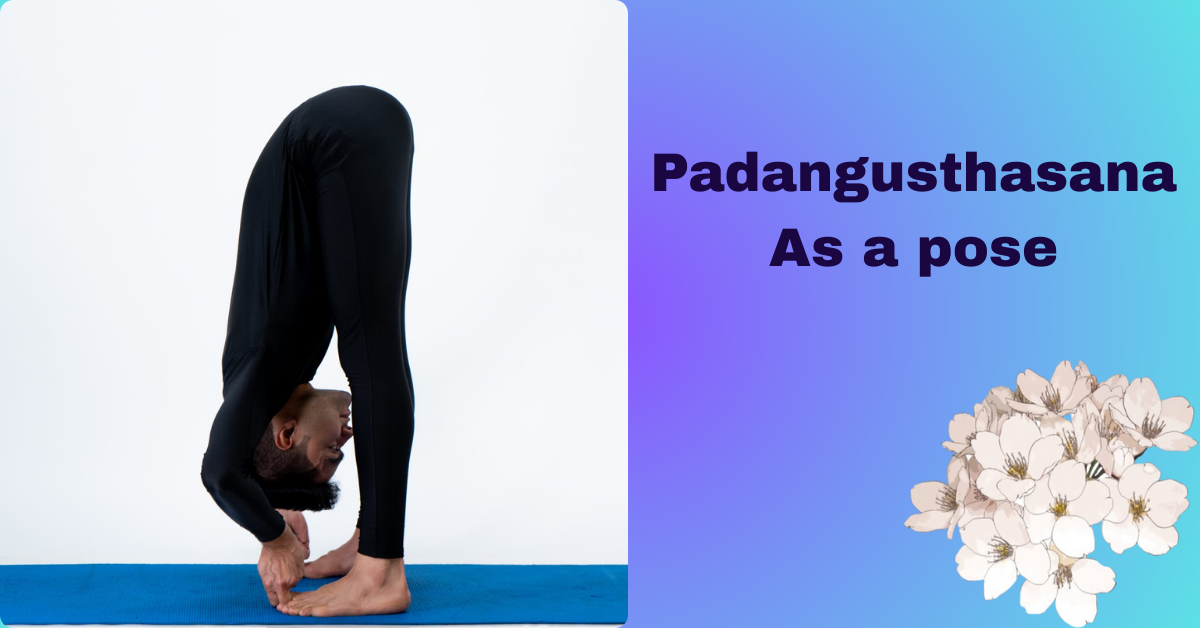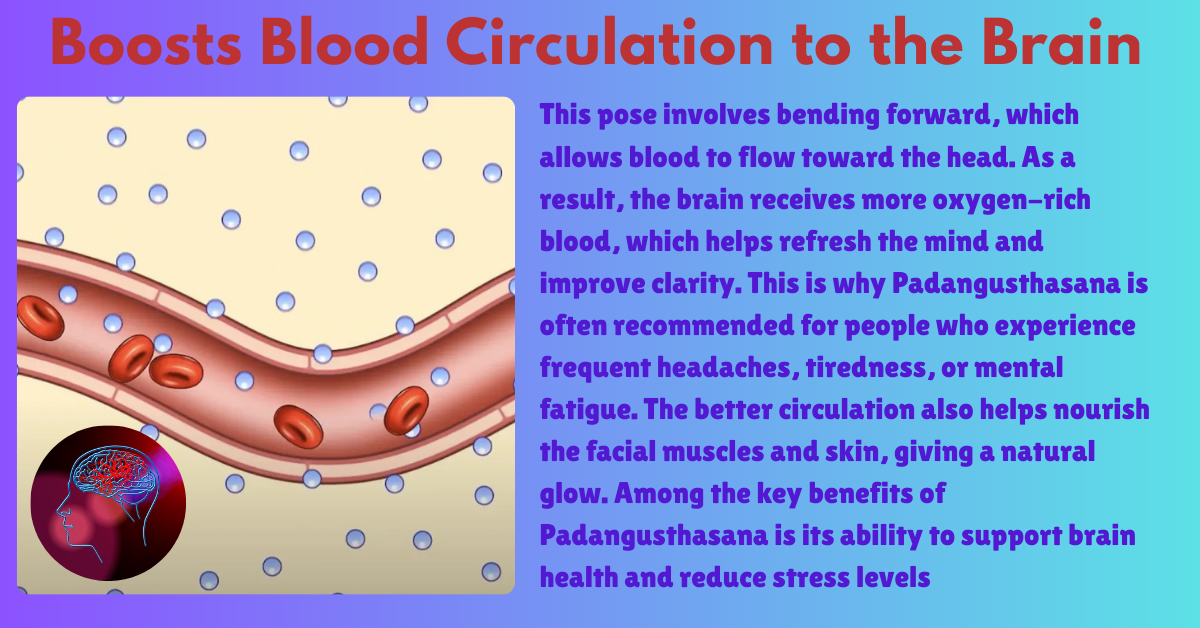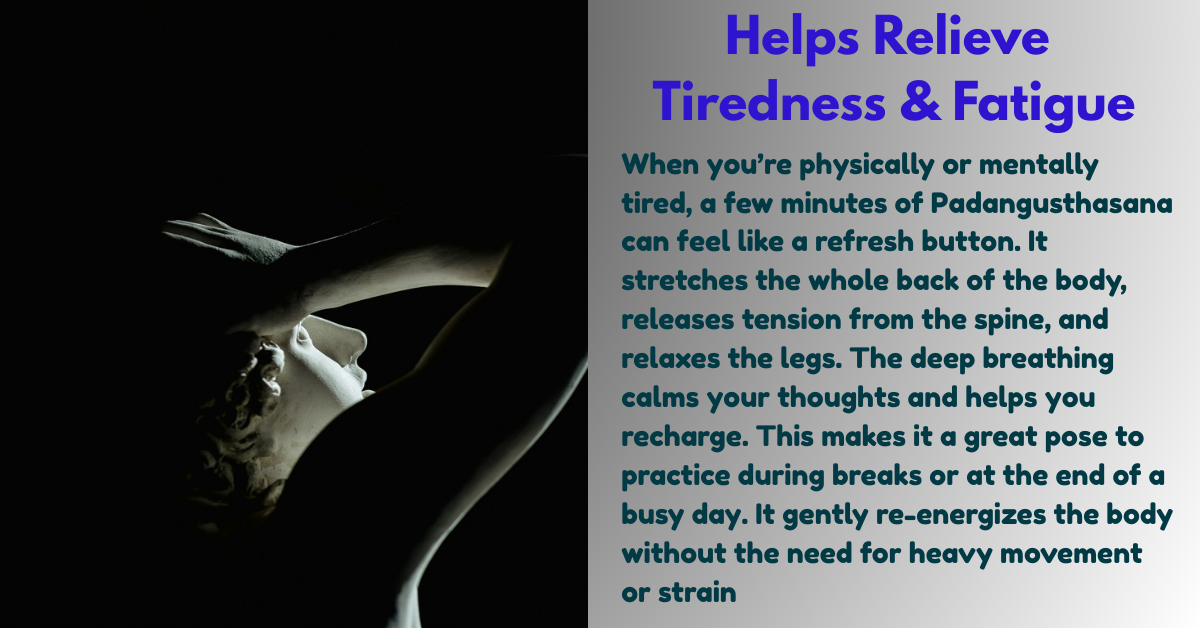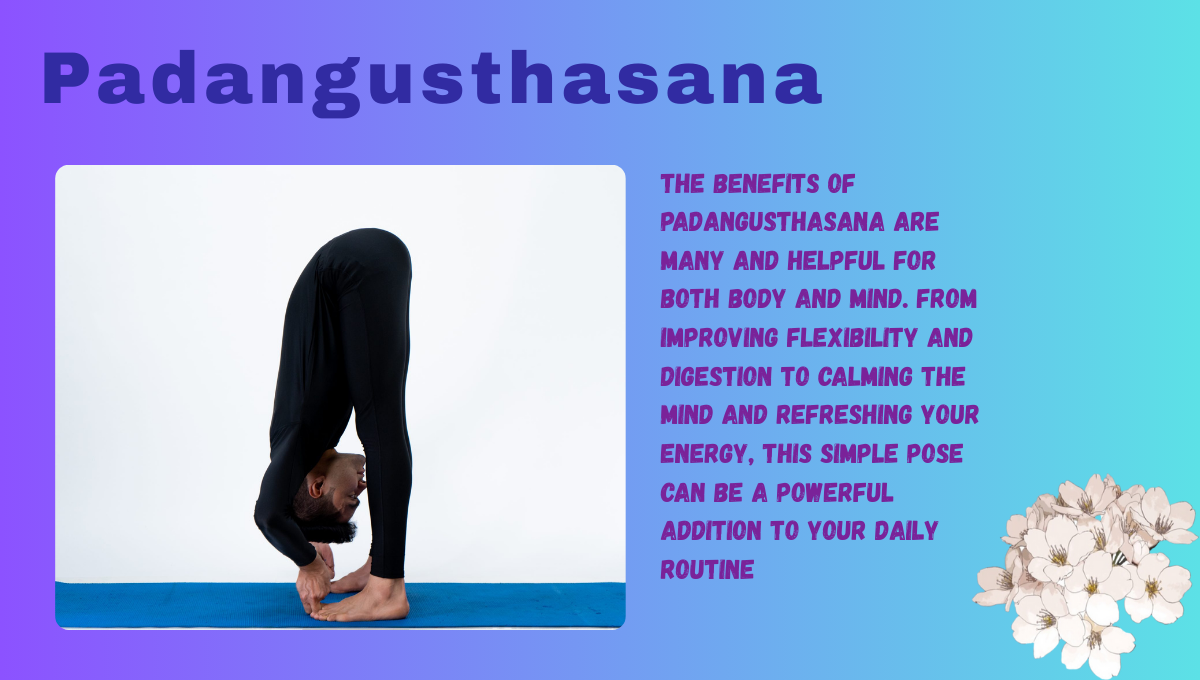Padangusthasana benefits__
What is Padangusthasana?
- A straightforward and classic yoga practice, padangusthasana is sometimes referred to as the “Big Toe Pose.”
- “Pada” means “foot” and “Angustha” means “big toe” in Sanskrit.

- Standing straight, bending forward from the hips, and trying to clasp the big toes with the fingers are the steps involved in this position.
- Although it might seem like a simple stretch, it calls on flexibility, balance, and steady breathing.
- In order to warm up the body and stretch the back of the legs, this pose is frequently performed at the start of a yoga practice.
- Lower back and hamstring flexibility can be enhanced with padangusthasana.
- Additionally, it encourages blood circulation in the head and upper body and stimulates the abdominal organs.
- Regularly performing this stance helps to relax the mind and promote mental focus.
- “Padangusthasana benefits” include promoting improved digestion through the gentle massage of internal organs.
- It also aids in lowering anxiety and weariness, particularly when paired with calm, deep breathing. Over time, this stance also improves stability and balance.
- Most age groups can benefit from padangusthasana, particularly those who wish to enhance their posture, lower their stress levels, and become more conscious of their bodies.
- Before trying it, anyone with high blood pressure or spinal problems should do it carefully or get advice from a yoga specialist.
- Padangusthasana gets simpler and more beneficial for the body and mind with time and consistent practice.
Importance of Padangusthasana in Our Daily Life__
- Our bodies and minds frequently experience stiffness, tension, and bad posture as a result of prolonged standing or sitting in today’s fast-paced lifestyle.
- Our physical and emotional well-being can improve with everyday Padangusthasana practice.
- The muscles in the legs, spine, and hips are stretched and strengthened by this yoga pose.
- Additionally, it increases blood flow to the brain, which calms the mind and lessens anxiety.
- Relieving neck and back stress is one of “Padangusthasana benefits.”
- Stiffness is a common complaint among people who spend a lot of time sitting at workstations or screens.
- This position encourages a healthier spinal alignment and gently opens the back of the body.
- Moreover, it aids in digestion by stimulating the abdominal organs, which is especially helpful in dealing with bloating or indigestion.
- Its ability to relax the nervous system is another crucial feature.
- Regular Padangusthasana practice helps promote emotional equilibrium and mental clarity.
- Frequent stretching in this position also helps people who are physically active avoid injuries and tight muscles.
- Among “Padangusthasana benefits” is the enhancement of focus and concentration.
- The mind is trained to remain in the present by maintaining the stance steadily and taking deep breaths.
- Professionals, students, and anybody else who needs mental acuity can all benefit greatly from this.
- In summary, Padangusthasana is a straightforward yet effective yoga stance that complements our daily schedules and provides excellent physical and mental health support.
Padangusthasana-A boon for Boosts Blood Circulation to the Brain__
“Padangusthasana benefits” for Boosts Blood Circulation to the Brain
- Padangusthasana gradually bends the upper body forward to improve blood flow to the brain.
- More oxygen-rich blood may reach the head in this posture, which promotes mental clarity and enhances brain function.

- Increased blood flow to the brain can enhance mental clarity, focus, and memory.
- Because of this, it’s an excellent stance for anyone looking to improve their attention, including working professionals and students.
- Additionally, the forward bend calms the nerve system, which eases stress and promotes mental relaxation.
- Frequent use of this pose can alleviate mental fatigue and possibly help avoid headaches brought on by bad posture or stress.
- One of the most notable of “Padangusthasana benefits” is its ability to increase cerebral circulation, which is a straightforward and natural method of reviving the mind without the need for any outside instruments.
For Whom is Padangusthasana Necessary?
- Many people find that padangusthasana is a beneficial yoga practice, particularly those who struggle with stress, bad posture, or tense bodies.
- It is especially important for people who spend a lot of time standing for extended periods of time, using a computer, or sitting at a desk.
- These individuals frequently experience weak leg muscles, lower back pain, and tight hamstrings.
- Stretching the backs of the legs, improving posture, and strengthening the spine are all benefits of padangusthasana..
- Students and working professionals who suffer from mental exhaustion and lack of focus might also benefit from this stance.
- Increasing blood flow to the brain is one of “Padangusthasana benefits,” as it helps enhance focus and lessen mental stress.
- For anyone seeking serenity and improved mind-body harmony, it is perfect.
- Because it promotes healthy digestion and stimulates the abdominal organs, this position is also beneficial for people who have digestive issues.
- Padangusthasana can help athletes and fitness enthusiasts stay flexible and prevent muscle tightness.
- Under supervision, elderly people who are active and have some flexibility can also attempt this pose.
- However, it should be avoided or used carefully by people who have severe back pain or injuries.
- In conclusion, “Padangusthasana benefits” are appropriate for a broad spectrum of those who wish to maintain their physical and mental flexibility, including office workers, students, fitness enthusiasts, and older residents.
Important Precautions About Practicing Padangusthasana__
- Even though Padangusthasana has several advantages, it’s crucial to do it safely.
- Unless instructed by a yoga specialist, people with slipped discs, lower back pain, or recent surgery should avoid this position.
- People with high blood pressure or pregnant women need to be especially careful.
- Never bow your knees abruptly or push the stretch.
- You should always warm up before trying the posture.
- Ask for help or practice close to a wall if you have trouble balancing or feel lightheaded.
- Steer clear of bouncing when bending forward.
- Safety should always come first, even though “Padangusthasana benefits” include increased flexibility and easier digestion.
- Move carefully and pay attention to your body.
- This stance can be gratifying and safe if you take the right precautions.
How to Perform Padangusthasana__
- First, stand upright with your feet hip-width apart to perform Padangusthasana.
- Breathe in slowly, then bend forward from the hips rather than the waist as you exhale.
- Try keeping your back straight and touching your toes.
- Take hold of your big toes with your thumbs and first two fingers.
- Bend your knees a little if you are unable to reach.
- Holding the toes, slowly pull them while keeping your head relaxed and slightly raising your chest.
- Hold this posture for a few moments, then slowly raise yourself while taking another breath.
- Calmly, without straining your body, do this stance.
- Stretching the legs and calming the mind are two of “Padangusthasana benefits.”
- Your balance and flexibility will naturally improve with consistent practice.
Another most important “Padangusthasana benefits”:
“Padangusthasana benefits” for Improves Flexibility in Legs and Spine
- Strong yoga poses like padangusthasana increase the flexibility of the legs and spine.
- Your hamstrings, calves, and lower back get a deep, mild stretch when you bend forward and attempt to grip your big toes.
- Regular exercise helps to improve range of motion and progressively reduce stiffness in the joints and muscles.
- Because it lengthens the spine and opens up the body, it is particularly beneficial for those who sit for extended periods of time or have tightness in the back of their legs.
- Maintaining proper posture is made easier by this stance, which also helps to relax the lower back and enhance the spine’s natural curve.
- It helps athletes and fitness enthusiasts because it promotes fluid body movement and lowers the chance of injury.
- Increasing overall body flexibility over time is one of “Padangusthasana benefits,” which makes you feel lighter, more balanced, and more energized for daily tasks.
“Padangusthasana benefits” for Aids Digestion and Stimulates Organs
- Improved digestion and internal organ vigor are two advantages of padangusthasana.
- This pose involves bending forward, which applies little pressure to the abdomen region.

- This motion helps to activate and stimulate the digestive organs by massaging the stomach and intestines.
- The digestive system functions more effectively as a result, enhancing food digestion and lowering issues like indigestion, constipation, and bloating.
- Additionally, this stance improves blood flow to the abdominal organs, supporting their long-term health and functionality.
- Regular practice of this position may be beneficial for people who have trouble digesting food or who feel uncomfortable after eating.
- It improves general gut health and makes it easier for the body to get rid of waste.
- Among “Padangusthasana benefits” is its capacity to promote a healthy digestive system without the use of medication.
- This position can be a useful component of a digestive routine that promotes long-term comfort and wellness, especially when combined with other yoga techniques and mindful eating practices.
“Padangusthasana benefits” for Reduces Anxiety and Calms the Mind
- In addition to being beneficial for the body, padangusthasana also helps to soothe the mind and lessen worry.
- Your mind automatically slows down and your nervous system relaxes as you bend forward in this pose and concentrate on your breathing.
- A feeling of calm and stability is produced by the deep, steady breathing and the light pressure applied to the head.
- This helps relieve accumulated stress, tension, and emotional pressure.
- Regular practice of this posture helps to calm and focus the mind.
- It’s particularly beneficial for those who struggle with worry, restlessness, or overthinking.
- To encourage deeper relaxation and greater sleep, many yoga practitioners do this position right before bed.
- Supporting mental clarity and emotional equilibrium is one of “Padangusthasana benefits.”
- This position becomes an effective tool for coping with everyday stress and maintaining mental clarity and strength when paired with regular breathing techniques or meditation.
“Padangusthasana benefits” for Enhances Body Balance and Stability
- Padangusthasana enhances the body’s general stability and balance.
- Your legs and core muscles must remain strong and stable when you bend forward and attempt to hold your toes in order to maintain the posture.
- This improves your control over your motions by activating minor stabilizing muscles, particularly in the thighs, calves, and tummy.
- Your awareness of your body grows as you practice, which makes it simpler to move fluidly and maintain your balance while standing securely.
- This benefit is beneficial for everyday activities like walking, climbing stairs, and standing for extended periods of time, in addition to yoga.
- Strengthening your physical base makes your body more steady, coordinated, and self-assured when you move. This is one of “Padangusthasana benefits.”
“Padangusthasana benefits” for Helps Relieve Tiredness and Fatigue
- An excellent pose to do when you’re feeling emotionally and physically exhausted is padangusthasana.
- The muscles in the back, legs, and spine—where stress and exhaustion frequently accumulate—are stretched by this forward-bending position.

- The mind can relax and the body can rest when one bends down. It has a cooling and relaxing impact that revitalizes your vitality and the nervous system.
- Additionally, the pose promotes deeper breathing, which increases the body’s intake of oxygen.
- This lessens the sense of fatigue and heaviness.
- Even a brief period of Padangusthasana practice can reduce tension, release bodily stiffness, and restore your sense of lightness and energy.
- Because of this, the pose is particularly helpful after a long day of standing for hours on end, traveling, or working.
- Even without much exertion, people frequently experience a sense of calm and relaxation after striking this pose.
- One of “Padangusthasana benefits” is its mild ability to naturally alleviate weariness, providing rapid inner peace and profound relaxation.
Conclusion:
Padangusthasana is a straightforward yet effective yoga practice that has numerous mental and physical benefits. It improves posture and flexibility by stretching the hips, spine, and legs. It calms the mind and lowers tension while improving focus and mental clarity by increasing blood flow to the brain. This pose eases fatigue, promotes digestion, and eases stiffness from extended standing or sitting. Additionally, it enhances stability, balance, and general body awareness. Regular practice can result in long-lasting physical and mental wellness, making it appropriate for professionals, students, fitness enthusiasts, and elderly persons (with caution). All things considered, “Padangusthasana benefits” make it a useful supplement to everyday living.
FAQ:
In what ways might Padangusthasana enhance flexibility?
An excellent pose for stretching the legs, particularly the calves and hamstrings, is padangusthasana. The rear of your body is softly stretched when you lean forward and attempt to hold your big toes. The body becomes more flexible and muscle stiffness is reduced with regular practice of this stance. Those who have lower back or leg tightness will find it extremely helpful.
Can digestion be improved by Padangusthasana? If so, how?
Padangusthasana can indeed help with digestion. Your abdominal muscles and stomach are softly compressed when you bend forward. The digestive organs are stimulated by this gentle pressure, which improves their function. It can ease indigestion, bloating, and gas. Regularly performing this pose could result in a more active and healthy digestive tract.
What “Padangusthasana benefits” are there for the mind?
Reducing stress and anxiety is one of Padangusthasana’s most soothing effects. The forward bend calms rushing thoughts and relaxes the nervous system. Taking calm, deep breaths while maintaining the position can help you reach mental clarity and peace. After a long day, it’s a fantastic way to relax.
Can postural issues be resolved with Padangusthasana?
Yes, improved posture can be supported by padangusthasana. It helps to strengthen and lengthen the neck, shoulders, and back. This helps you sit and stand more upright over time. By stretching the spine and releasing tension, this position can help those who spend a lot of time on computers or mobile devices improve their posture.
Who may gain the most from Padangusthasana practice?
All ages can gain from it, but students, office professionals, athletes, and senior citizens particularly benefit. Padangusthasana is beneficial for anyone seeking to enhance digestion, relieve tension, or increase flexibility. With minor modifications if necessary, this relaxing stance can be performed by people of most fitness levels.
Is it possible for Padangusthasana to enhance concentration and focus?
It can, really. Your brain receives more oxygen when you perform Padangusthasana with mindful breathing because it improves blood circulation. This improves concentration and focus. Because it increases alertness and dispels mental fog, it’s a great pose to incorporate into your morning routine before studying or working.
Does Padangusthasana aid with fatigue relief?
Of course. Among the calming “Padangusthasana benefits” is its ability to relieve tension in the legs and spine, which are common places for people to store stress. After spending a lot of time standing or sitting, it is rather revitalizing. Just a few minutes of this position practice can increase your energy levels and help you feel more calm and rejuvenated.

